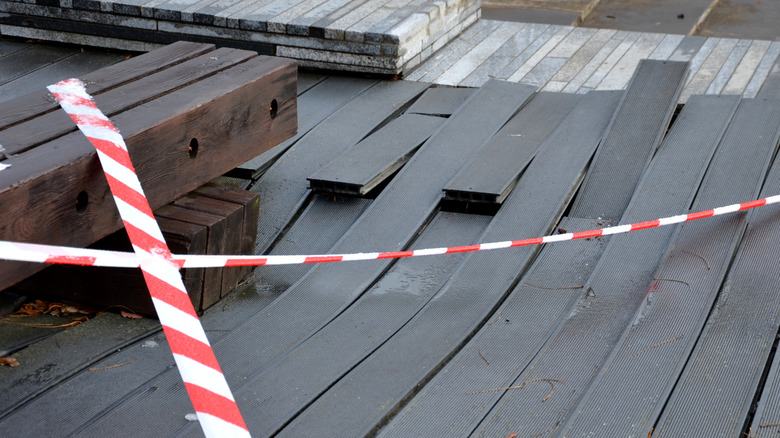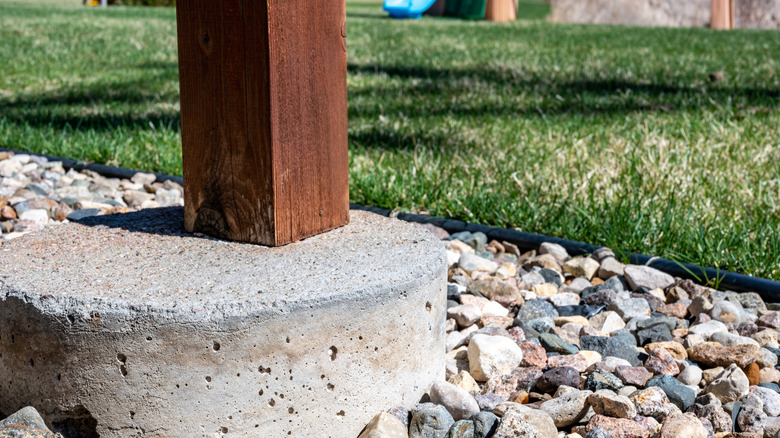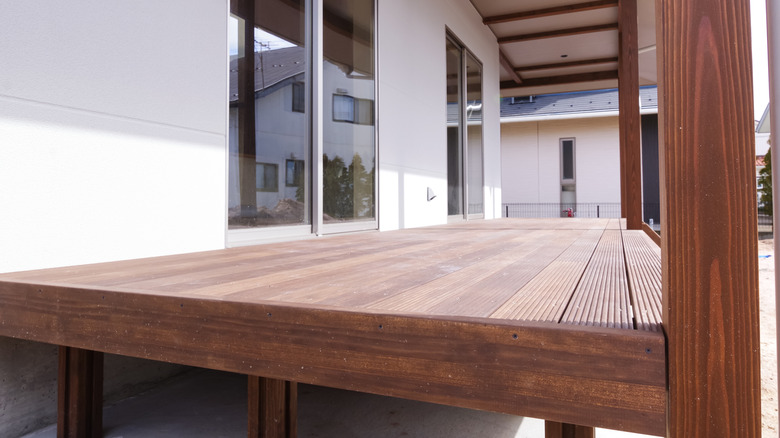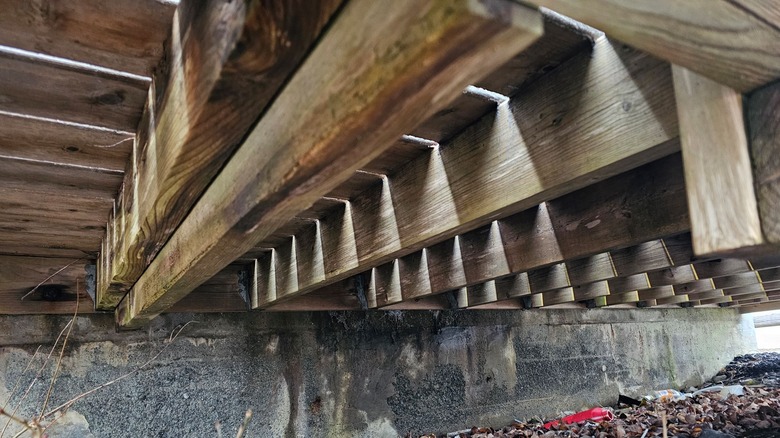5 Deadly Signs That Your Deck Is Going To Collapse
We've gotten so accustomed to over-engineered homes that we trouble ourselves with fretting over relatively small details (Is the vapor barrier intact around that outlet? Can the range hood be on a two-way switch?) while not stressing over catastrophic failures. After all, when was the last time you heard of, say, a deck collapsing?
But according to a study of Consumer Product Safety Commission data, deck and porch collapses injure 6,654 people a year. With 40 million decks that are over two decades old, perhaps these numbers shouldn't be surprising. Those engineering safety margins that make us so comfortable on decks and everywhere else in our homes are based on the year one condition of the deck; the engineers have no way of knowing the effect your parties, sprinklers, incompetent handyman brother-in-law, etc. might have on the deck after two decades.
Fortunately, if you're on the lookout for them, there are some early warning signs that can alert you to deck troubles before something tragic happens. Even for older construction, deck repair is usually possible... though there are certainly cases in which a wood deck is beyond repair. And the first sign of trouble for a deck, repairable or not, is usually inappropriate movement somewhere in the wood — the railings, perhaps, or the framing's overreaction to a good round of jumping jacks. Sometimes there's no perceptible movement, so the most reliable way to detect deck problems is with a visual inspection.
If your deck is nailed to your house, be wary of potential devastation
According to the International Association of Certified Home Inspectors, around 90% of deck collapses can be attributed to the deck separating from a house. After a 2003 porch collapse in Chicago that killed 13 and injured 57, standards were changed so that decks could no longer have their load-bearing ledger boards attached to homes with mere nails. New building codes require ½-inch or larger lag screws to do the work of keeping deck and house together (through-bolts may also be used, but usually aren't, because the other end of the fasteners often can't be inspected). As a rule of thumb, you should have a minimum number of lag screws at a calculated distance between each other that equals 100 divided by the length of the deck joists. So, then, a deck with 10-foot joists would require a lag screw every 10 inches.
Identify your deck's ledger board and inspect the fasteners. If you have nails, it's time to drive in appropriately spaced lag screws. If you have lag screws that aren't properly spaced, add more until they are. And the most critical bit of all: if there's a gap between the house and the ledger, stay off the deck and call an inspector. Chances are you can just tighten the screws to reposition the deck, but only a trained professional can tell you for sure. And don't forget to check the condition of any flashing or caulk that is in place to protect the ledger boards from water exposure and rot.
Precarious footings are another common cause of deck collapse
Unsurprisingly, it's also pretty important that the posts holding your deck up are doing their jobs. Have a look at the posts that hold up your deck. Are they in good condition in the place where the post meets the concrete footing? There should be a metal plate and fasteners mechanically connecting the post to the footing, even if it's a pre-cast concrete pier that holds the post in place horizontally. The connectors should not be corroded, and the post should be centered on the footing. Posts themselves should be 6x6 inches or larger in most cases.
Check for level where all posts connect to your deck. That is, the points where the posts and beams intersect should always be on the same level. If they're not, investigate the level of the footings; it's possible that one or more footings are sinking due to erosion, being placed in soil disturbed at the time of construction, or for other reasons. Inspect the footings themselves for any cracking, and call in an inspector if you find any of these issues. Check the soundness of the connections between posts and beams. Through-bolts should be tight, with no gaps between the wood components. And check for wood rot, especially at the tops and bottoms of the posts, and particularly if wood comes into contact with the ground at any point. If you can easily drive a screwdriver into wood ½ inch or more, rot might be an issue for your deck.
Corroded metal is a bad sign of deck problems
As with the metal post-to-footing connections, be careful to look for corrosion in any other metal components of your deck. The ledger board lag screws should be stainless or galvanized steel, for example, and mostly free of rust or corrosion. But galvanized steel is not permanently impervious to corrosion from water, so pay particular attention to galvanized joists hangers that connect the deck's floor joists to the ledger board and rim joists at the ends. Galvanized joist hangers on decks exposed to moisture are frequently corroded, and can become dangerously so. Stainless steel hangers have less of an issue with moisture-based corrosion.
Also familiarize yourself with the appearance of galvanized and stainless connectors and fasteners. While it's unlikely to be a problem for stainless joist hangers, for example, using stainless nails with galvanized hangers, or vice versa, can lead to electrolytic corrosion between the two metals that will definitely degrade galvanized hangers. If you see, or think you see, signs of mismatched connectors and fasteners, or if you see substantial corrosion, call in an expert to replace them with properly matched components. Corroded fasteners can also cause deterioration of the wood they're sunk in, so be on the lookout for signs of damage to the boards around corroding nails or screws.
Look out for splits, cracks, or rot in the deck's framing
Split or cracking wood is usually a sign of failure in progress. It can be caused by a number of factors like past or current stresses, aging wood, and toe-nailed joinery. According to InterNACHI's "How to Perform Deck Inspections," inspectors should be on the lookout for splits or cracks that are longer than the wood itself is deep, and for "excessive cracking overall" in any area of a deck's structural framing. Visible splitting can also be caused by freeze-thaw and dry-wet cycles.
Splits and cracks along wood's grain are usually not a cause for concern, but they must be inspected to determine the nature and severity of the problem. If you see splitting across the wood's grain, however, or long areas of gray mold or darker wood, it could be a sign of rot caused by brown-rot fungi, or dry rot. Termite activity is also a sign of dry rot. Dry rot destroys decks quickly and must be stemmed immediately, and a deck suffering from it should not be used until the fungus is remediated and an inspector gives the deck's condition a thumbs-up. Problems with gutters, sprinkler systems, flashing, plumbing, and other issues can also contribute to other kinds of rot. Any resulting damage should be corrected, and the cause identified and eliminated.
Don't forget about deck railing failure
While not, strictly speaking, a deck collapse, there's no doubt that a failed deck railing can still throw you to the ground violently — and you're unlikely to quibble about the distinction when it does. According to CPSC statistics, about 12% of deck-related injuries are caused by railing failures. Your most important tool for identifying railing problems is looking for shakiness or give when you attempt to push against the railing. Deck railings are required to withstand 500 lbs. of pressure in any direction, so you shouldn't notice any sign of movement or instability when you try this, and if you do it could indicate deterioration due to rot. Insect damage is also a possible cause, so it pays to be aware of how to identify deck-damaging pests. Check the fasteners where railing posts attach to the deck's framing. They are subject to all the potential problems discussed above, and fasteners in problem connections should be tightened or replaced. Don't forget to test the railings on stairs, where railing problems are actually the most dangerous.
Improper railing construction is one of the most dangerous mistakes made when designing a deck, so there are a few design and construction issues to look out for regarding deck railings as well. Make sure posts are attached with guardrail brackets. Acting as a lever, a post can exert as much as 1700 lbs. of pressure on its fasteners when a mere 200-lb. force pushes it from the guardrail, so the brackets are usually a necessity. And ensure that vertical rail posts and balusters are capped or cut at an angle on top to shed water and prevent rot.





